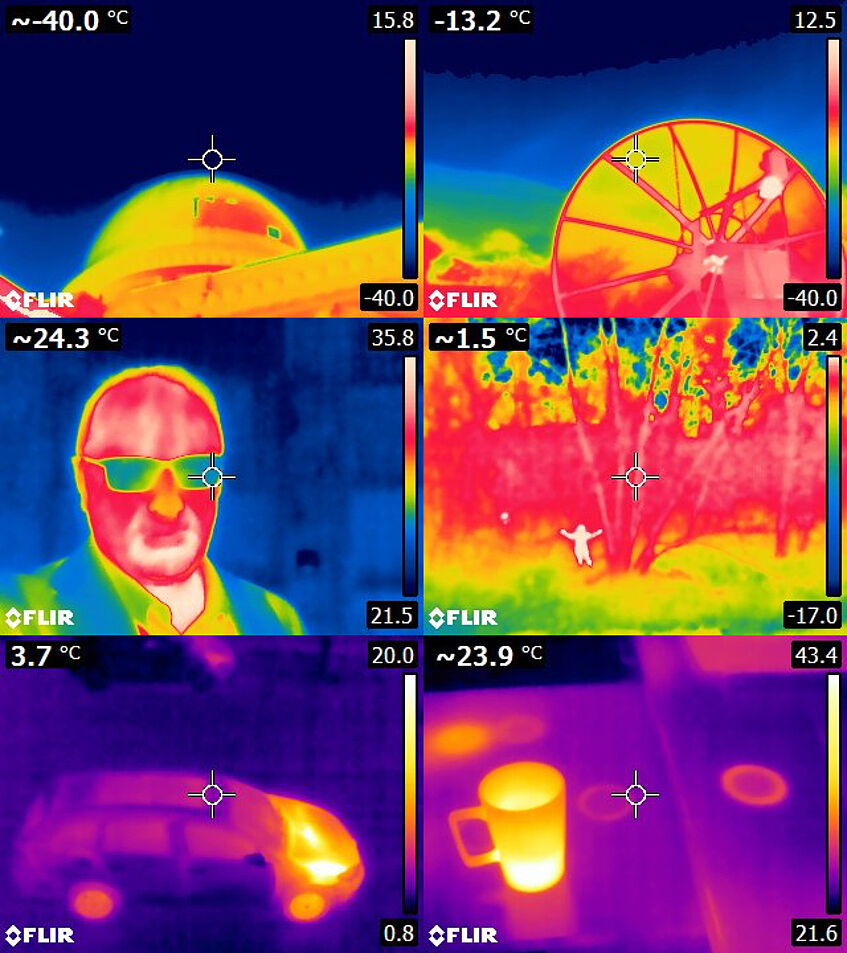More experiments
... and instructions to do them yourself
On the first glance, infrared radiation is something mysterious, because it is invisible. But with a few simple experiments and illustrations we can learn more about it and its applications. Here is a short list of experiments and instructions, through which we can learn more about the nature of infrared radiation.
Infrared radiation in everyday life
Infrared remote-control
A well-known everyday application of infrared radiation is the use of infrared signals in remote controls. Most remote controls, such as for televisions or stereos, have an infrared transmitter installed, with which the remote communicates with the device. For successful signal transmission, the infrared signal, which the remote control transmits via a diode, must arrive at the receiver of the device. For this, the diode must be free, but it not necessarily needs a direct line of sight between the remote control and receiver because infrared radiation can be reflected on surfaces, similar to optical radiation.
Experiment 1:
Hold your hand directly in front of the infrared diode of your remote and try to use it. Does the signal arrive at your device anyway? How close can you hold your hand in front of it until the signal stops? How far away can you go from the device?
Experiment 2:
Aim your remote directly away from your device and try to operate the device. Does it work, does the signal arrive anyway? Where do you have to aim, that no signal arrives? On which surfaces is the signal swallowed, and on which it is reflected so that it still arrives at the device?
Experiment 3:
Take a digital camera or cell phone camera and take a picture or even a video of the infrared diode of your remote while you are using it. Can you make the signal, that is invisible to our eyes, visible in the photo or video? How do you think the remote can send different signals for different keys you press?
Outsmarting a motion detector
In everyday life, motion detectors are often used to automatically turn on lights when there are people nearby. Most motion detectors measure the infrared radiation in their environment and send a signal to the connected lighting when the measured infrared radiation suddenly changes. So if a person moves in the measuring range of the motion detector, the detector discovers the body heat that is radiating from the person.
Experiment:
Find a motion detector connected to a light source and try to activate it when you pass by. Organize a rescue blanket as it is available in first aid boxes. This rescue blanket is a thin foil that consists of a silver and golden layer and is intended for cooling or warming of (injured) persons. Both sides of the foil very effectively reflect incident radiation. With the silver side of the foil, either body heat can be reflected back to the body for warming, or can be kept from outside for cooling solar radiation.
Try to hide under a rescue blanket and slowly walk past the motion detector. Are you able to shield your body heat well enough that the light is not switched on?
Experimente mit der Wärmebildkamera

Experimente mit der Wärmebildkamera
With a thermal imaging camera, we can visualize infrared radiation directly and display it as an image. The detectors of the camera operate in the infrared range and convert the incident radiation into measured temperatures, which are displayed in a color image. Typically, hot things are depicted in white and red, while cold things are blue and black. In the picture on the right we show six different thermal images of everyday situations. The top two images show the roof of the University Observatory in Vienna, where you can see the dome of the observatory (left) and a radio telescope (right). The building and the radio telescope stand out clearly from the sky background and have a higher temperature. With the radio telescope, the components that are actively supplied with power and perform electronic work are especially warmed up, which is why they are displayed white in the picture. The middle two shots show Prof. Franz Kerschbaum in his office and Magdalena Brunner in the surrounding park. The portrait photo shows which facial regions are better supplied with blood and therefore warmer than others. The glasses, on the other hand, shield the infrared radiation from body heat, which makes them opaque and cooler than the rest of the face. When you look at the picture on the right you can see that people in the infrared can clearly stand out from the surrounding nature when the outside temperature is significantly below the body temperature. Even from afar and in the dark, people can be discovered easily. The two shots at the bottom of the picture show a car that has just been driven and a teacup that has just been moved. Under the bonnet of the car the residual heat that comes from the operation of the engine is still visible. The tea cup with warm tea also leaves residual heat at the table, which can be visualised with the infrared camera.
The world in the light of infrared radiation can be quite surprising and make the invisible visible. Which everyday scenes would be particularly exciting to be observed in the world of infrared radiation?
What does a pot of boiling water look like?
Where are the heating pipes hidden in my apartment?
Where are the hottest components in a computer?
Which materials are transparent or opaque to infrared radiation?
Where is my window leaking?
